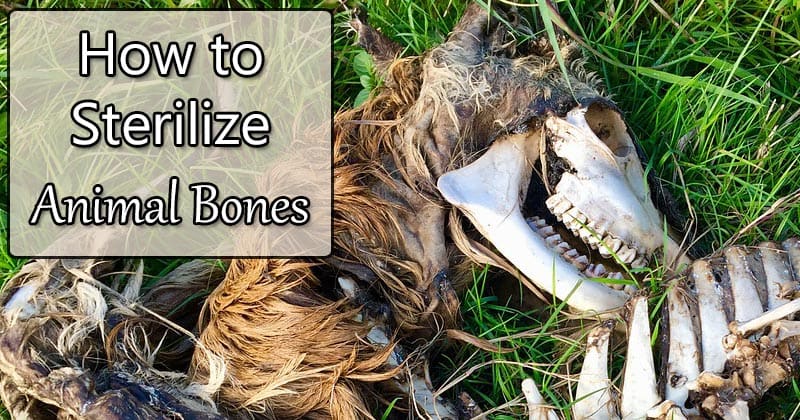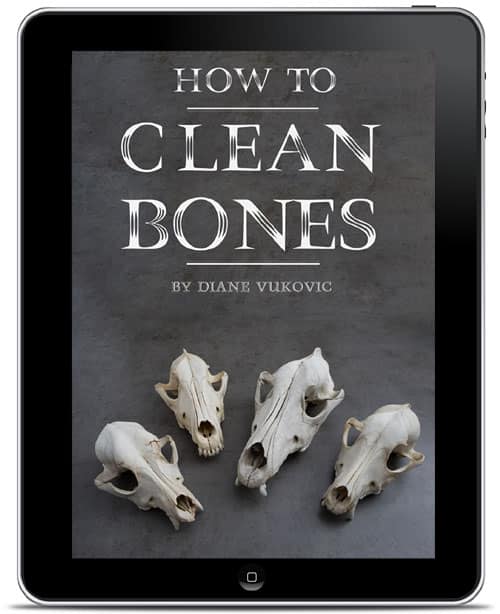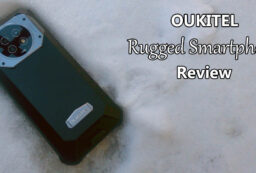Did you find some animal bones or a skull? Especially if there is still flesh on the bones, they can contain all sorts of nasty bacteria, viruses and parasites. Sometimes there will be mold or algae growing on animal bones you find too. And let’s not forget about the nastiness on bones which have passed through an animal’s digestive tract, as is the case with bones from owl pellets.
Obviously these aren’t things you want to touch or get into your air ducts. You’ll need to sterilize the bones before displaying them. Don’t worry – it’s actually pretty easy to sterilize animal bones.
Removing Tissue from Animals Safely
If the bones still have soft tissue on them, you’ll need to remove this first. You’ll want to be VERY careful when handling any dead animals which still have tissue on them. You don’t know how the animal died and you could expose yourself to serious viruses or other infectious diseases in the process.
Wear gloves and protective clothing to keep fluids off your clothes. Wear a respirator mask and safety glasses, especially if you need to chop a fresh dead animal off to get to the bones. And wash your hands repeatedly!
The best method for removing soft tissue is to soak the bones in warm water. Read how to remove tissue from bones here.
Best Ways to Sterilize Bones
1. Hydrogen Peroxide (Recommended)
Hydrogen peroxide is a disinfectant which can kill bacteria, viruses, molds and parasites. The problem with using hydrogen peroxide to sterilize bones though is that it is slow-acting. You also need a fairly high concentration to effectively kill pathogens. If you dilute the hydrogen peroxide too much, it won’t be as effective.
To sterilize bones with hydrogen peroxide:
- Use at least 3% strength hydrogen peroxide
- Soak the bones in the hydrogen peroxide for at least 10 minutes
- You can’t just spray the hydrogen peroxide on the bones as there may be pathogens inside the bones
Note that hydrogen peroxide is also used to whiten bones. I’ve found that a 10 minute bath in 3% hydrogen peroxide won’t whiten the bones too much (you’ll need a longer soak to get bones really white). However, if you prefer to leave the bones more natural-looking, then you might want to use ammonia instead.
2. Ammonia
Ammonia is another disinfectant that you can use for sterilizing bones. It is good at killing parasites but not as effective against bacteria. However, ammonia is also great for removing fat from bones (de-greasing). On fatty species like possums and pigs, you might have to do an ammonia soak anyway. Ammonia doesn’t whiten bones though. So, if you already plan on whitening bones and they aren’t greasy enough to warrant an ammonia soak, then you should just use hydrogen peroxide for sterilization.
To sterilize bones with ammonia:
- Use only clear ammonia
- Dilute the ammonia to 2.5% strength
- Only use ammonia outside in well-ventilated areas
- Wear a respirator mask, gloves AND goggles. Seriously – it can cause serious damage if it splashes in your eyes!
- Soak the bones in the ammonia mixture for 30 minutes
- Let the bones completely air dry before bringing them back indoors
3. UV Light
Ultraviolet light from the sun is a great disinfectant. If you find bones in the desert, for example, they probably are already sterile enough from sun exposure that you don’t need to do anything else to them. In theory, you could leave your animal bones out in bright sunshine to kill pathogens on them.
Unfortunately, this method isn’t very reliable. There are no clear guidelines on how long objects must be left in the sunlight to be completely sterilized. And the sunlight will only kill pathogens exposed to the sun – not any pathogens lurking deep inside the bones.

These bones are probably already sterile from UV light. (Unfortunately, not my picture)
4. Sterilizing Owl Pellets
I actually don’t sterilize owl pellets. Instead, I just make sure to wash my hands after retrieving the tiny bones. The bones then get sterilized with a hydrogen peroxide soak. If the owl pellets are for kids though (who tend to touch their mouths a zillion times), it’s probably best to sterilize them first.
To sterilize owl pellets:
- Pre-heat an oven to at least 250F
- Line a baking tray with aluminum foil
- Put on gloves
- Wrap the owl pellets in aluminum foil
- Bake the owl pellets in the oven for 40 minutes
*Don’t try to sterilize owl pellets with liquids like hydrogen peroxide or ammonia. Once wet, the pellets start to stink and it’s really difficult to get the bones out.
In theory, you could also sterilize other types of animal bones with this method. However, I would NOT try it with large bones or skulls. It’s too tricky to get large bones in the oven without contaminating your kitchen. And any leftover tissue could end up stinking up your entire kitchen as it bakes! On top of that, baking dries out bones and increases the risk that they will crack.
NOT Recommended for Sterilizing Bones
- Bleach: Never use bleach on bones. It will break down the bone tissue, causing them to become brittle and frail over time.
- Boiling: Boiling will sterilize bones. And, while some people do boil bones to get soft tissue off, it generally isn’t recommended. The high temperatures can soften and destroy the bones, especially smaller bones.
- Vinegar: Vinegar will dissolve and soften bones. Plus, it isn’t even a good disinfectant.
Want to learn more about cleaning bones for collecting?
Check out my eBook.














Post your comments